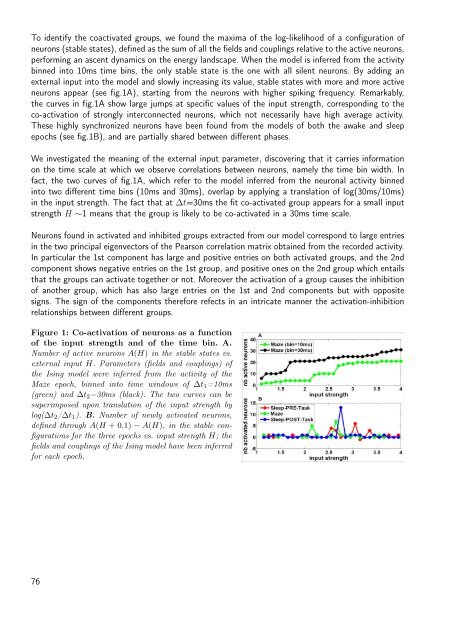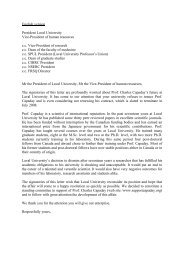Untitled - Laboratory of Neurophysics and Physiology
Untitled - Laboratory of Neurophysics and Physiology
Untitled - Laboratory of Neurophysics and Physiology
You also want an ePaper? Increase the reach of your titles
YUMPU automatically turns print PDFs into web optimized ePapers that Google loves.
To identify the coactivated groups, we found the maxima <strong>of</strong> the log-likelihood <strong>of</strong> a configuration <strong>of</strong><br />
neurons (stable states), defined as the sum <strong>of</strong> all the fields <strong>and</strong> couplings relative to the active neurons,<br />
performing an ascent dynamics on the energy l<strong>and</strong>scape. When the model is inferred from the activity<br />
binned into 10ms time bins, the only stable state is the one with all silent neurons. By adding an<br />
external input into the model <strong>and</strong> slowly increasing its value, stable states with more <strong>and</strong> more active<br />
neurons appear (see fig.1A), starting from the neurons with higher spiking frequency. Remarkably,<br />
the curves in fig.1A show large jumps at specific values <strong>of</strong> the input strength, corresponding to the<br />
co-activation <strong>of</strong> strongly interconnected neurons, which not necessarily have high average activity.<br />
These highly synchronized neurons have been found from the models <strong>of</strong> both the awake <strong>and</strong> sleep<br />
epochs (see fig.1B), <strong>and</strong> are partially shared between different phases.<br />
We investigated the meaning <strong>of</strong> the external input parameter, discovering that it carries information<br />
on the time scale at which we observe correlations between neurons, namely the time bin width. In<br />
fact, the two curves <strong>of</strong> fig.1A, which refer to the model inferred from the neuronal activity binned<br />
into two different time bins (10ms <strong>and</strong> 30ms), overlap by applying a translation <strong>of</strong> log(30ms/10ms)<br />
in the input strength. The fact that at ∆t=30ms the fit co-activated group appears for a small input<br />
strength H ∼1 means that the group is likely to be co-activated in a 30ms time scale.<br />
Neurons found in activated <strong>and</strong> inhibited groups extracted from our model correspond to large entries<br />
in the two principal eigenvectors <strong>of</strong> the Pearson correlation matrix obtained from the recorded activity.<br />
In particular the 1st component has large <strong>and</strong> positive entries on both activated groups, <strong>and</strong> the 2nd<br />
component shows negative entries on the 1st group, <strong>and</strong> positive ones on the 2nd group which entails<br />
that the groups can activate together or not. Moreover the activation <strong>of</strong> a group causes the inhibition<br />
<strong>of</strong> another group, which has also large entries on the 1st <strong>and</strong> 2nd components but with opposite<br />
signs. The sign <strong>of</strong> the components therefore refects in an intricate manner the activation-inhibition<br />
relationships between different groups.<br />
Figure 1: Co-activation <strong>of</strong> neurons as a function<br />
<strong>of</strong> the input strength <strong>and</strong> <strong>of</strong> the time bin. A.<br />
Number <strong>of</strong> active neurons A(H) in the stable states vs.<br />
external input H. Parameters (fields <strong>and</strong> couplings) <strong>of</strong><br />
the Ising model were inferred from the activity <strong>of</strong> the<br />
Maze epoch, binned into time windows <strong>of</strong> ∆t 1 =10ms<br />
(green) <strong>and</strong> ∆t 2 =30ms (black). The two curves can be<br />
superimposed upon translation <strong>of</strong> the input strength by<br />
log(∆t 2 /∆t 1 ). B. Number <strong>of</strong> newly activated neurons,<br />
defined through A(H + 0.1) − A(H), in the stable configurations<br />
for the three epochs vs. input strength H; the<br />
fields <strong>and</strong> couplings <strong>of</strong> the Ising model have been inferred<br />
for each epoch.<br />
76



